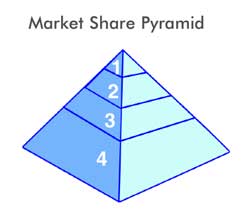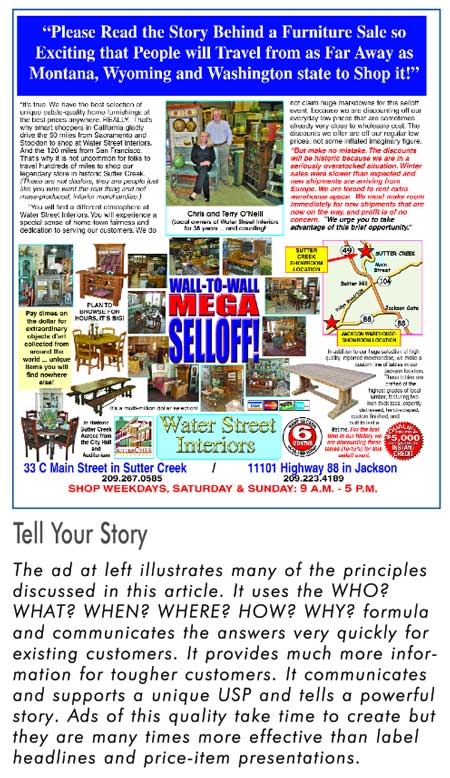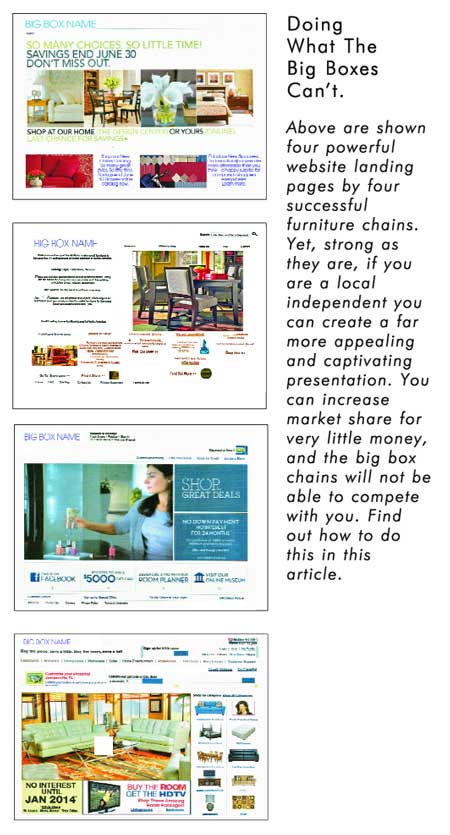Part 2 of the “Sell Lots More” Series.
by Larry Mullins
If you are an independent furniture retailer, this may be the most important article you read this year. In the May/June 2010 issue of FURNITURE WORLD, five principles were presented that have the potential to change everything for you. Each of these principles will lead you toward more sales, larger tickets, and more frequent customer visits. And, best of all, the big boxes cannot compete with you in these “Blue Ocean” areas. This article will discuss how to use these principles to begin creating a USP (Unique Selling Proposition) and set a new wave of profitable business into motion for very little cost.
 |
LEVEL 1 (Easy, but small): Old Customers who know your store, like you, and happen to need something. These are easy to reach and motivate. Lazy ads and boring websites will work. But they will never penetrate very deep to new prospects.
LEVEL 2 (Medium, a bit larger): Prospects who are on the fence and have noticed your ads before. They may have heard some nice word-of-mouth advertising from friends. Harder to convince, you will need a good promotion and a persuasive story.
LEVEL 3 (Difficult, but fairly large): Prospects who need home furnishings but don’t know much about you. You are a stranger. A much tougher sell, and you will need to communicate a strong “WHO” factor and a killer USP.
LEVEL 4 THE MASS MARKET of PROSPECTS: Rich market share possibilities abound on this large and difficult to reach level, but these are people who don’t know you at all. The WHO? WHAT? WHEN? WHERE? HOW? WHY? formula must be masterfully applied, your USP expressed, and your story told in an engaging fashion.
|
First, let’s review the five principles where the BBs (big boxes) are weak and foundering. These are potentially powerful game-changers for independent furniture retailers:
1.Home furnishings advertising is, generally, hastily prepared by technicians who have no concept of the Evidence-Based Advertising principles that make advertising cost-effective and productive, or by harassed CEOs who lack the time and knowledge to create effective local ads.
2. Home furnishings advertising too often lacks personality, and is often a sterile series of label headlines and price-item offers. There is rarely, if ever, a credible USP (Unique Selling Proposition) that makes the store stand out from the crowd. The consumer’s question, “Why should I buy my home furnishings from you and not your competitor?” goes unanswered.
3. Home furnishings websites are usually created and maintained by technicians who have no understanding of the principles that make written messages compelling. These sites are cold, lack dazzling USPs, engaging personal videos, and easy to find and follow content that informs and enlightens information-hungry potential customers.
4. Most home furnishings stores grossly under-perform because the staff is not united in understanding the USP of the organization, its long-term mission, or its short-term targeted goals. In addition, at least a dozen rich possibilities of potential plus-business are left unexplored.
5. A store must establish itself as a trustworthy friend, the preeminent expert in home furnishings in it’s market area by clearly expressing the values it shares with the community in every aspect of its operations before it’s messages will be believed. Successful internet marketers understand this, but very few home furnishings stores are taking the steps necessary to achieve USP continuity and credibility in every aspect of what they do.
USP BEGINS WITH THIS ADVERTISING FORMULA
My formula for creating a powerful, cost-effective ad is simple. It is based upon the principle that we live in an information age. People want information, not hype. And they want it fast. The formula is: 5W+1H=SCEA. (Five W’s plus one H equals Super Cost Effective Advertising.) I know that sounds complicated, but it is actually very simple. Another name for this formula is “WHO? WHAT? WHEN? WHERE? HOW? and WHY?” … just like in journalism 101. The only caveat to the formula is that ALL of these questions must be answered for the prospect within ten or fifteen seconds. How this turbo-charged communication is achieved, and how this method contributes to having a devastating USP, is the gist of this article and exhibits.

Four website BB (Big Box) landing pages are shown in the exhibit on page 38. These are expensive, slick products. They were all created by top technical people. And, like the ads of these BB stores, they answer the questions posed by the 5W+1H formula. And they answer these questions about as effectively as most independents:
1. WHO? They all contain a sig or logo.
2. WHAT? They all announce they sell home furnishings. Often they announce a big sales event.
3. WHEN? Time durations for events are given.
4. WHERE? Local stores addresses are findable.
5. HOW? Credit information is provided.
6. WHY? Claims are made for special benefits if you shop the BB.
So, you might ask at this point, “So, what is missing? How can I compete with massive ad campaigns that dominate the market, and websites that blow people away?” The answer is that plenty is missing, and you can compete with slick, fancy websites. The cyber playing field is almost level for big and small stores. And, an enterprising local independent can run circles around a huge BB and its remote, centrally-operated IT department.
Although BBs have giant IT departments doing their websites, the pros in these departments are overworked and understaffed. They are also virtually untrained in Evidence-Based Advertising principles. By learning something about creating effective headlines and mastering the art of telling your story, you can run circles around any BB out there when it comes to winning new prospects in your local marketing niche.
The reason this is true is that the BBs use bare-bones answers to the 5W+1H formula. Which is fine for customers who have shopped them, who like them, who know them, and if the BB has something cool going on. In this case, it does not take much to convince customers to come in. But this bare bones appeal will not increase market share.

PROSPECTS ARE A MOVING TARGET
Other than direct mail or permission emails to preferred customers, the truth is that you are not advertising to a static audience, you are advertising to a parade. This is all the more true when it comes to your website. While your existing customer base does not need as much incentive or information, to other prospects you are a complete stranger. This is especially true of website visitors who are much less likely to know you and who are looking for information. These prospects wonder: Why should they trust you? WHO are you, anyway? And this is the broader WHO factor that can turn the tide for you in your local market area.
When communicating to existing customers, your name and address is usually adequate. They are the top of the pyramid. (See the pyramid exhibit). These customers are easy to reach, but there are far fewer of them than there are prospects. It is from the huge body of prospects, not from your old customers, that your biggest opportunities to increase market share will emerge.
Too many merchants and ad people believe that when they put their logo on an ad they have satisfied the WHO factor. As far as websites go, they believe that having a link that says “ABOUT US” that takes the reader to a long boring story about the store (that no one ever reads) will satisfy the WHO factor for the prospect. In truth, when a prospect views an ad or a website they are often meeting you for the first time. They would appreciate a human touch here. On the level of corporate web presence, it would be nice to “meet” the guy in charge, if only by means of a brief video. Not one Big Box website I visited featured a compelling video of a living, breathing, CEO who communicated a passion for selling beautiful home furnishings to prospective customers.
The value of such an introductory video is twofold. Videos help your Google ranking. Plus, when they feature the boss, they command the attention of the prospect vastly better than static, anonymous copy. This observation is not a matter of opinion, it has been proved statistically. In addition, Brett Beemer’s research indicates that prospects in the store feel honored when they are waited on by the boss. Being greeted by the boss when you enter an internet domain also captures the attention of the prospect in a far more favorable way than a screaming headline. Of course the BBs could choose to do this effectively, but so far they have generally failed to grasp this idea. Moreover, a local appeal by a hometown merchant is much more effective in local markets. And here is where you have the advantage. The massive, remote BB IT departments are simply unable to deliver personal local messages.
Make no mistake: If you establish your WHO factor effectively it will exponentially increase your credibility as a marketer. A video is a relatively simple addition to your landing page that is not expensive, and will provide years of free WHO factor power. In the same vein, a photo of you in your ads is an element of the WHO factor. Quotes around your headline in conjunction with your photo will increase readership. You will be judged by how you look, of course. A shirt, tie and jacket greatly improves the impression you make. And sales persons who adhere to a similar uniform dress code help as well, because they are you when they represent you in the store.
MORE “WHO?” FACTOR IDEAS
There is still more to the “WHO?” factor, and how it relates to your USP and your effectiveness in print, direct mail and on your website. Two key principles that are constantly ignored by the BB folks are these:
• Always try to say something that no one else can say.
• Always try to show something that no one else can show. These important factors put the “unique” in your USP.
The sad truth is that you could switch the sig identification on nearly all BB ads, mailers, and websites and no one would know the difference.
For example, is your “slogan” something that no one else can use? Or is it just meaningless, cute fluff? Which impresses you more, a fluffy slogan anybody could use that says: “We make comfort our business,” or the one used by Curt Pierce of Pierce Furniture in Muscatine, Iowa that says: “A great place to get comfortable since 1900”? A dealer once told me, “Larry, this longevity thing is such a tiny issue. Why fuss about it?” I explained that my job is to look for these tiny fractions of a percent of improvement, here—there—everywhere, because they add up. Each is a small part of the accumulated power of your USP and your WHO factor.
Walt Disney was a great exponent of the WHO factor. He was passionate about the way his staff looked. He was passionate about what they said. He was passionate about how they performed. Mike Vance tells the story of how Walt would constantly walk around Disneyland and check out all these things. The Japanese call this “Gemba Kaizen.” Gemba refers to the workplace, and Kaizen is the philosophy of continuous improvement. We call it “Management by Walking Around.” Instead of hiding in his office, Disney was always out there among his customers, making sure that his people were giving folks a “good show.”
All of Disney employees work from a script. It is more of a talking points memo than a memorized dissertation. Once Walt Disney was making his rounds, dressed casually, smoking his pipe and wearing his famous slouch hat. Unnoticed, he boarded the “Jungle Cruise.” When it was completed, he took the Disney associate aside who drove the cruise and who had given the talk that accompanied it. “Son, we spent several million dollars on this ride, with all its animals and jungle environment. It was designed to take seven minutes to complete. You did it in four and a half minutes. You are short-changing our guests.” Then Disney left without another word.
The Disney associate was crushed. He reviewed his script and realized he needed to take his time and emphasize certain phases of the cruise. He began to do so, and hoped one day Walt Disney would come back and check him out. Two months went by before Walt showed up again and took his place on the boat. After a flawless performance that lasted just over seven minutes, the associate waited anxiously for Disney to comment. But Disney passed quietly by, and simply gave the associate a smile and a “thumbs up.” This gesture of approval was a peak moment the young man never forgot.
Your own associates should brainstorm questions that may come up about a product, an event, or selling situations and devise appropriate talking point replies. You can stage many stimulating sales meetings around this idea.
SHOW SOMETHING NO ONE ELSE CAN SHOW
Many big boxes have gorgeous, spacious interiors and displays but you would never know it from their ads or websites. They show only static photos of items with label headlines and prices. This item-price approach fails to tap into the imagination of the prospect. The prospect is not interested in a sofa or a recliner. She is interested in a beautiful home. So if you show her an illustration of a sofa or a recliner that she is not interested in, you lost her, regardless of the price. On the other hand, if you show her a spacious showroom brimming with ideas, you light up her imagination. If you have a beautiful showroom and show only item-price in ads, you are giving away a massive advantage to smaller companies.
By the way, you can get your newspaper to take good digital shots of your interior. But, you must give them direction. Nine out of ten times they will walk around and shoot individual living room, bedroom and dining room groups. What they must capture is the broad scope of your displays to kindle the imagination of prospective customers.
YOUR ELEVATOR USP SPEECH
Your elevator speech is the great test of your USP.
Imagine you are on an elevator, and a prospective customer walks in. She recognizes you as a local furniture store entrepreneur. As the doors close, she asks you this question:
“You know, I am going to spend quite a lot of money soon on furniture and new mattresses. I’d like to patronize you as a local merchant, but I am just not sure. Why should I buy my home furnishings from you and not that big chain store?” You have seconds to answer her question before she gets off the elevator. What would you say?
If you want to have some fun, test your staff to give their best elevator speech in a sales meeting. Strive to devise one yourself. It should be no more than 100-150 words. It should be crafted in the interest of the consumer and must embrace your USP factors. This is also your story. People don’t like a sales pitch, but they love stories. (See the exhibit from Water Street Interiors on page 34 for a sample of a compelling story.)
In this article I have attempted to convince you of the importance of the WHO factor. As you have seen, it is vastly more than your store name. The WHO factor embraces the entire personality of your store and expresses your USP. It establishes your niche in the marketplace. You can’t win over everyone, but if you are effective in defining and targeting your niche you will generate more traffic and more sales. Here is where you have the opportunity to create your own “Blue Ocean” because you are operating in an industry in which the big hitters all look and sound alike. The consumers’ situation is like someone with a headache going into a drug store and seeing bottle after bottle labeled “medicine.” You will stand out because you are focused on your niche, you look different, you say different things, and you fire up the imagination of prospects and relieve their “headaches” with your passion. You understand the strategy of preeminence, a killer USP, and the principles of evidence-based advertising.
Larry Mullins is a contributing editor for Furniture World and has 30+ years experience on the front lines of furniture marketing. Larry’s mainstream executive experience, his creative work with promotion specialists, and mastery of advertising principles have established him as one of the foremost experts in furniture marketing. His turnkey High-Impact programs produce legendary results for everything from cash raising events to profitable exit strategies. His newest books, THE METAVALUES BREAKTHROUGH and IMMATURE PEOPLE WITH POWER … How to Handle Them have recently been released by Morgan James Publishing. Joe Girard, “The World’s Greatest Salesman” said of this book: “If I had read Larry Mullins’ book when I started out, I would have reached the top much sooner than I did.” Larry is founder and CEO of UltraSales, Inc. and can be reached directly at 904.794.9212. See more articles by Larry at www.furninfo.com or www.ultrasales.com.